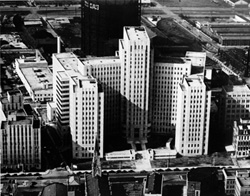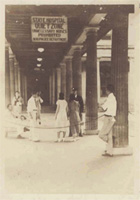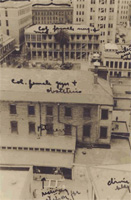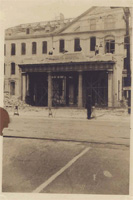|
The
Sixth Charity Rises
The Charity
of the 1920's and 1930’s would be unrecognizable to
medical students today. At that time, the Charity Hospital
complex stretched from its current location at Tulane Avenue
and Lasalle to where Interstate 10 now stands. In the rear
of this block, on Gravier Street, was a shabbier building
that housed black patients; Charity was still very much segregated.
In between was a beautiful courtyard, full of balconies, palm
trees, and a fountain.

Inside the hospital,
prevailing medical knowledge and poor conditions reigned.
Patients were frequently boarded two to a bed, with some sleeping
on the floor. Babies were kept two to a crib. Infectious disease,
especially sexually transmitted diseases, were extremely prevalent
at this time. Charity was one of three locations in the country
to conduct research on childhood congenital syphilis. In one
study, over 150 children with congenital syphilis were enrolled.
Treatment of adult syphilis at that time, prior to antibiotics,
consisted of weekly injections of arsenic and bismuth for
eighteen months. One physician that ran the venereal disease
clinic estimated he treated around 500 patients with syphilis
each day.
In 1937, Charity
Hospital began its first modern postgraduate residency program,
replacing the old house physician and house surgeon system.
This reflected the growing trend towards medical specialization
and growing authority of specialty certification boards. Medical
students at Tulane and LSU competed fiercely for internship
spots at Charity. Postgraduate students at Charity had a now-rare
degree of authority, as well as a huge patient population
from which to learn. In 1936, Charity’s admission rate
over the year exceeded that of Cook County in Chicago, Bellevue
in New York, and Los Angeles County Hospitals. The daily patient
census was 2,781, in spite of a bed capacity of 1,814. One
physicians, remembering Mardi Gras in 1937, said, “In
trying to make rounds at night, I literally stepped over bodies
of the sick lying in the aisles. It was not unusual for one
of two patients in a bed to go tell the nurse, ‘My bed
mate has just died.’”. These conditions received
national attention via Time Magazine and the AMA, and the
need for a new Charity was widely accepted.
No plans could
be drawn up, however, until Huey Long was assassinated in
1935. Long was a fierce opponent of Roosevelt and his New
Deal, and had gone so far as to ensure passage of a law in
Louisiana that forbade any use of federal funds for any reason.
After Long’s death, his successors healed the rift with
Roosevelt, the law was repealed, and Works Progress Administration
grant funds were approved for a new Charity hospital in September,
1936, and the 1832 Charity Hospital building was demolished.
The construction
of the new Charity Hospital, completed in 1939, was rife with
political favors and shoddy construction. Political favors
and monies were taken out of the Charity construction budget
and architects were forced to cut corners to pay for such
handouts. These shortcuts ranged from buying second-hand,
dilapidated electrical equipment to completely eliminating
fire escapes in the original building. The new structure was
in the shape of an H, modified to comply with the segregation
laws of the time. Each wing belonged to Tulane or LSU’s
medical service.
Immediately problems
became apparent with the structure. In a disquieting parallel
to substandard Army Corps of Engineers construction of the
levees that gave way during Hurricane Katrina, there were
several thousand less pilings used in the Charity construction
than were called for, and those that were used extended only
28 feet into the soft New Orleans ground when plans called
for them to be driven to a depth of 43 feet. This resulted
in the settling of Charity almost 18 inches by 1943, along
with massive bills for repair of resulting cracks in the walls
and other structures.

Two of Tulane’s
most famous surgeons were on the staff of Charity during these
war years: Alton Ochsner, and Tulane School of Medicine graduate
and Ochsner’s student, Michael DeBakey. Their personalities
could not have been more different: Ochsner was understanding
and calm-natured, while DeBakey was nicknamed “Black
Mike” by surgery residents for his hard-nosed attitude
and lack of bedside manner. Ochsner, as chair of surgery,
conducted Grand Rounds and “bullpen” sessions
with medical students. The tradition of bullpen continues
today. Perhaps Ochsner’s most famous sayings was “Early
to bed, early to rise, work hard and publicize.”
Around this time
Ochsner lobbied the Dean and Board of Tulane to build a private,
academic Tulane hospital and to create a surgical clinic headed
by Ochsner. The University Board as well as the School of
Medicine felt a separate clinic would be criticized by alumni
and create discord in the faculty, and rejected the idea.
Ochsner then decided to form his own private clinic. With
local financial support and federal funds, the Ochsner Foundation
Hospital and Clinic was opened in 1954.
Tulane faculty
made many medical advances with the help of Charity patients
during these years. Grace Goldsmith, a nutrition researcher,
established minimum dietary requirements for niacin and tryptophan.
Oscar Blitz and Louis Monte, both at Charity, were the first
to describe bagassosis, a severe respiratory disease first
described in sugarcane farmers. The first heterologous kidney
transplants, from a monkey to a human, were performed by Tulane
surgeons at Charity. George Burch, an internist at Tulane,
was instrumental in the discovery of hemoglobin SS. William
Castle, a Harvard hematologist who discovered intrinsic factor,
suggested to the famous chemist Linus Pauling that he study
why red blood cells assume a characteristic sickle shape in
those with sickle cell anemia. Pauling asked Burch to supply
blood of patients with sickle cell anemia and then analyzed
the hemolyzed samples in a gel that separated hemoglobin based
on size. This experiment was the beginning of modern molecular
biology, and the blood samples that made it possible came
from Charity patients.
prev | 1
| 2 | 3
| 4 | 5
| 6 | 7
| 8 | 9
| next |







